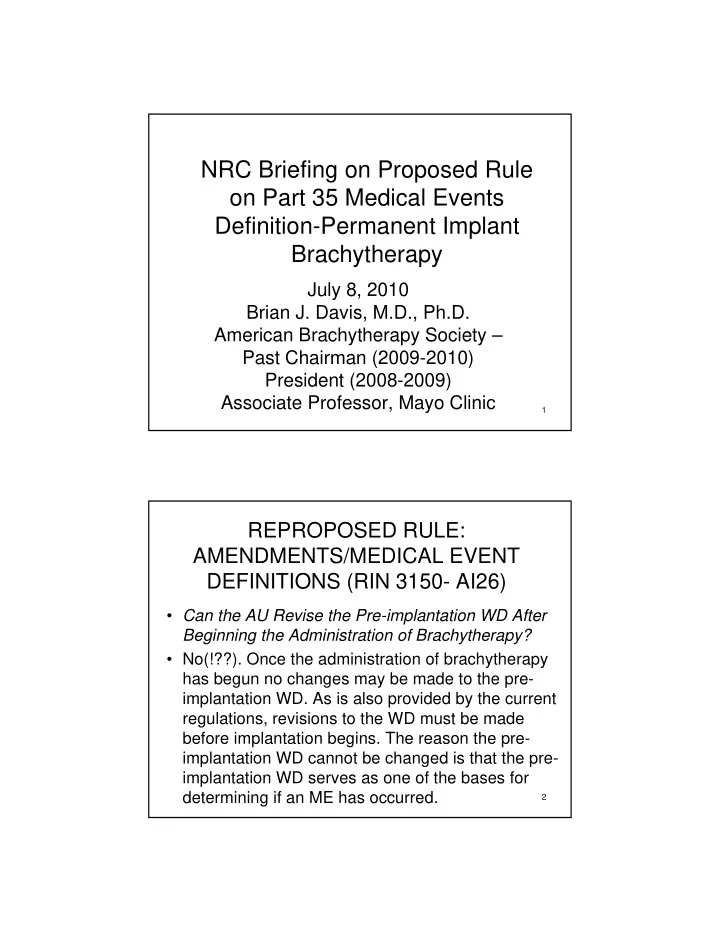

NRC Briefing on Proposed Rule on Part 35 Medical Events Definition-Permanent Implant Brachytherapy July 8, 2010 Brian J. Davis, M.D., Ph.D. American Brachytherapy Society – Past Chairman (2009-2010) President (2008-2009) Associate Professor, Mayo Clinic 1 REPROPOSED RULE: AMENDMENTS/MEDICAL EVENT DEFINITIONS (RIN 3150- AI26) • Can the AU Revise the Pre-implantation WD After Beginning the Administration of Brachytherapy? • No(!??). Once the administration of brachytherapy has begun no changes may be made to the pre- implantation WD. As is also provided by the current regulations, revisions to the WD must be made before implantation begins. The reason the pre- implantation WD cannot be changed is that the pre- implantation WD serves as one of the bases for determining if an ME has occurred. 2
REPROPOSED RULE: AMENDMENTS/MEDICAL EVENT DEFINITIONS (RIN 3150- AI26) • However, § 35.40(c) allows for an existing WD to be revised by an AU prior to beginning the administration in order to account for any changes in the treatment site (such as organ volume and shape) that may have occurred between the time of planning the treatment and the implantation procedure. 3 REPROPOSED RULE: AMENDMENTS/MEDICAL EVENT DEFINITIONS (RIN 3150- AI26) • Why is this wrong? – Volume change after a permanent seed implant is unpredictable, so a dose determination at a single time point may easily vary by more than an arbitrary 20%. – It will result in an over-reporting of ME’s without any justifiable clinical basis . – Excellent long-term results are reported for cases where intended dose prior to an implant varies by more than 20% after an implant. 4
REPROPOSED RULE: AMENDMENTS/MEDICAL EVENT DEFINITIONS (RIN 3150- AI26) • Is delivering a +/- 20% dose in permanent prostate brachytherapy routinely achievable? • Is it necessary? 5 6
Prostate Volume Changes and Seed Implants Sohljem, Davis et al., Int J Radiat Oncol Biol Phys 60(3): 2004 7 Postimplant to Preimplant Transrectal Ultrasound Volume Ratios Sohljem, Davis et al., Int J Radiat Oncol Biol Phys 60(3): 2004 8
Prostate D90s Using PrePlans Mayo Clinic Experience 1998-04 240 220 200 Prostate 180 D90 (Gy) 160 140 120 100 80 0 100 200 300 400 500 600 Implant Number Wilson TM, Davis et al. IJROBP 2004 9 Trend towards a decreased prostate D90 with case number but not significant (P=0.1); standard deviation of D90 decreased from 26.7 Gy to 13.6 Gy and was significant (P=0.0003) CP1206912-2 Prostate D90 of 395 Iodine-125 Cases Monotherapy 1998-2003: Mayo Clinic MN 200 40.0% 150 29.0% No. 100 14.0% 10.0% 50 3.0% 2.3% 0.8% 0.5% 0 80- 101- 121- 141- 161- 181- 201- 221- 100 120 140 160 180 200 220 230 Dose (Gy) 10 CP1187711-1
Mayo Clinic Experience RRP and Seeds: Matched Pair Study 1998-2003 Failure Event – Single PSA > 1.0 ng/ml Above Nadir RRP 100 Brachy Event free (%) 80 RRP n=822 60 Seeds n=274 40 20 P=0.367 0 0 1 2 3 4 5 Years after procedure 11 CP1192621-3 Conclusions • Permanent prostate implants produce excellent results even with >20% variation from treated to planned dose to the prostate. • The ACMUI recommendations are most consistent with the American Brachytherapy Society guidelines and current practice at the Mayo Clinic. Slide 12 12
Recommend
More recommend